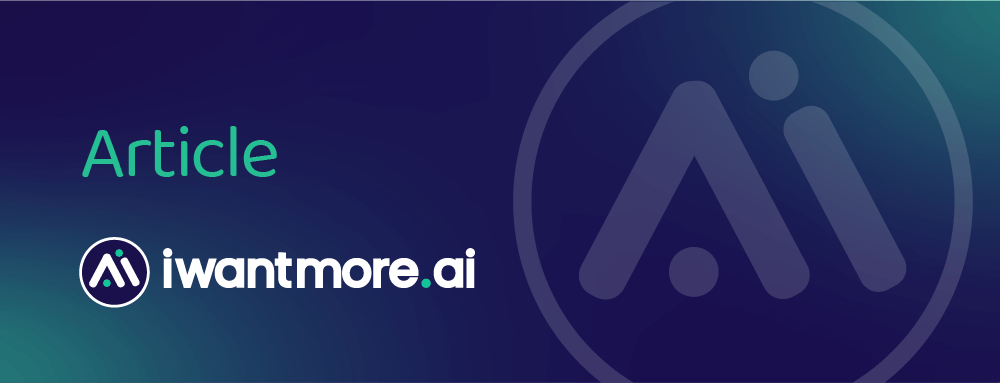
AI for business – nice to have or a competitive necessity?
The decision to adopt AI is no longer about jumping on the latest tech trend; it’s about survival. Sound overdramatic? Here’s what the Chief Product Officer at Cisco, Jeetu Patel, had to say about it in their latest AI readiness report.
“Eventually, there will be only two kinds of companies: those that are AI companies, and those that are irrelevant.”
(Incidentally, if you’re not sure how ready or not your business is for AI, take our quick AI readiness assessment.)
Now this message may be on the strong side, but for businesses who choose to delay or ignore implementing AI into their workflows and business, the risks are real, and the consequences could be significant.
Have you made the shift in mindset from AI as a nice to have, to a competitive necessity?
It’s been clear for a while now that companies that have embraced AI are seeing significant benefits across various sectors – i’m not sure this can be disputed anymore. This ranges from companies like Grind Coffee working with Google across multiple use cases, such as writing product descriptions, or emails to customers, to Klarna’s AI assistant that has already had 2.3 million customer service conversations.
AI is providing that competitive edge.
What are the risks of sitting on the fence and not adopting AI?
The first reaction of many business leaders is to look at the risks of implementing AI: privacy and security, bias, ethical concerns, accuracy. The list is actually quite long. This is probably why so many companies have locked down access to tools like ChatGPT.
But for businesses still on the fence, or even behind the fence, the risks of inaction need to be weighed up. Here are a few areas to consider for companies opting to ignore or postpone implementing AI:
1. Falling behind your competitors:
If your competitors are using AI, (and i’m generalising here) they can, more than likely, make faster, data-driven decisions with tools like Tableau, improve customer experiences with the likes of Zoho, and optimise their operations with the amazing Make.com. If you have fewer insights into how your business is performing, don’t know what your clients think and feel and have manual process throughout your operations, you are going to be losing clients to competitors who are more efficient and innovative.
2. Operational inefficiencies:
We mentioned manual processes a second ago, but it’s so important it’s worth calling out on its own. Without AI (and automation), businesses will be reliant on manual processes that consume valuable time and resources. This inefficiency can erode profitability and in many cases can be fixed with no-code tools like Zapier or Make.com for very little cost.
3. Missed growth opportunities:
There are a whole host of AI-powered tools that can create new revenue streams – whether through analysing customer behaviours with tools like Sprig, or predicting market trends with Quid. Without AI, these insights might remain untapped, leaving revenue on the table.
4. Talent drain:
If you don’t have AI infused across your organisation to eliminate mundane tasks, but your competitors do – who will win the war for talent? Forward-thinking employees want to work with the latest technologies. Businesses that are resistant to adopting AI may struggle to hire and retain top talent.
But if AI is so great, why are there still barriers to AI adoption?
In Slack’s recent Workforce Index, they report that executive urgency to incorporate AI tools into business operations has increased 7x over the past six months and is now a top concern, above inflation or the broader economy, and yet more than two-thirds of desk workers have never used AI at work.
So why aren’t people using AI at work?
There are a few primary barriers that hold many businesses back, including cost concerns, or lack of expertise, either at the technical level or skills such as prompting. However these can be solved pretty easily. It’s the non-obvious barriers that need looking at. Slack’s Workforce Index highlighted a few barriers I hadn’t considered before:
- The value of original ideas – 47% said that using AI feels like cheating.
- The value of effort – 46% of workers equate their value to effort and fear being seen as lazy for using AI.
These are clear leadership challenges that need a human level response. So how do you address these?
Build change management into your AI strategy
If your AI strategy doesn’t consider change management and communications, now is the time to address that:
It all about culture – addressing concerns about originality and effort in AI use requires leaders to foster a culture that reframes AI as a tool for adding value rather than cheating.
Reward the experimenters – leaders should recognise and reward outcomes over effort alone. Show that using AI to work smarter, not harder, is a skill.
Communicate – clear communication, training, and setting transparent guidelines on AI’s role in the workplace will help employees feel empowered rather than judged.
Don’t sit on the fence, the time to act on AI is now.
Find out where you are with AI today, educate your team, identify use cases and build an AI strategy with people at the centre.
If you want help with AI readiness, AI training or developing your AI strategy, contact us.
Other AI articles you may be interested in:

Governments across the world are racing to develop and deploy AI, but their approaches couldn’t be more different. The United States, China and the United Kingdom have all released formal action plans in 2025 that give us a clear sense of their priorities, politics and philosophies on AI. Here’s what they’re doing and what it tells us.

We say it to every business we meet. Regardless of the project, you can have the coolest, sexiest, best bit of tech out there, but without the people being on board it is a complete waste of time and money. Rolling out AI is no different. It’s about people. What’s the best way of bringing people along on any tech journey? Other people.

Artificial intelligence is hungry for energy. Behind every chatbot, Copilot, or agent are servers burning a lot of power. As more UK companies adopt AI tools, it's worth paying attention to how much energy those tools use and what that means for your sustainability targets and reporting requirements.

AI is no longer a future trend — it’s a present-day advantage. While some businesses are building AI agents and transforming operations, others risk falling behind. This article looks at what’s driving the AI divide, why foundational knowledge matters, and how even small steps can unlock real competitive value. If you’re standing still, you’re already losing ground.

It was only a year or two ago that the role of prompt engineer was being touted as the next great career path. Thousands of job ads appeared. People the world over updated their LinkedIn profiles to highlight their prompt engineering skills. Fast forward a couple of years and the role is already on its way out.

The CTO is swamped with the day to day, the COO wants to see progress, the CFO wants to see hard ROI, and the CEO is reading headlines about competitors appointing ‘Chief AI Officers’ and is wondering why you don’t have one too. If this sounds familiar in your business, you might be wondering whether it’s time to create (or hire) a dedicated AI leader.
iwantmore.ai – The AI consulting firm that helps you build a smarter business
Wherever you are with your AI implementation initiatives, we have a range of stand-alone AI quick start services to help you fast track the transformative benefits of AI across your business.



